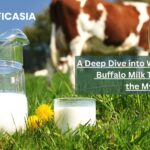Introduction
Although the word “huitlacoche” originally made me think of an interesting, possibly legendary animal, you might be surprised to learn about its actual form. From a biological perspective, “huitlacoche” is the name given to a fungus called “corn smut,” which infects corncobs and turns them into dark, delicious growths that are valued in Mexican cooking. However, when we explore the world of mythology and cultural perception, the name “huitlacoche” assumes a more fanciful meaning. It is here that the “animal huitlacoche” occurs, which is frequently connected to a particular bird, the curve-billed thrasher.
Its distinct flavor and unusual texture have contributed to its fame, despite its humble beginnings as a fungal infection of maize. This post delves into the realm of animal huitlacoche, examining its historical background, culinary applications, nutritional benefits, and cultural importance.
Sources and Practices
Corn can become infected with a fungus called Huitlacoche Animal, especially when there is a lot of humidity and warm weather. The fungus, officially named Ustilago maydis, grows on corn cob kernels and gives them a characteristic dark color. These growths are harvested and used as a culinary item; they are frequently compared to mushrooms or truffles.
Huitlacoche was seen as an annoyance in traditional Mexican agriculture since it decreased the quantity and quality of maize yields. But centuries ago, indigenous people in Mexico realized its earthy flavor and began using it in their meals, unlocking its culinary possibilities.
A Master Songbird with a Culinary Connection: The Curve-billed Thrasher
Because of its distinct flavor profile—which is regarded as earthy, smoky, and somewhat sweet—animal huitlacoche is highly valued. It goes nicely with many different types of food because of its rich, umami flavor. It is frequently used in Mexican food items like tacos, quesadillas, soups, and sauces.
Pajaro Huitlacoche is sometimes prepared by sautéing it with onions, garlic, and spices to improve its flavor. It gives richness and complexity to dishes like tacos and quesadillas when used as a filler. Huitlacoche can also be combined with cornbread batter to give classic recipes a novel touch, or it can be used as a topping for tamales.
The curve-billed thrasher is a fascinating bird that deserves attention despite its misleading name. It lives in arid scrublands and woodlands throughout Mexico and portions of the southwestern United States. It is well-known for its melodic and mimicry-filled songs. Its bent beak helps it forage for fruits, seeds, and insects, which gives it essential nutrition.
Curiously, the name of the thrasher, “huitlacoche,” has stuck and transcended the bird itself, becoming associated with a classic Mexican recipe that uses the huitlacoche fungus. The distinct flavor and texture of the fungus are highlighted in this culinary delicacy, which is frequently served with corn tortillas and queso fresco. This reinforces the cultural relationship between the thrasher’s name and the highly valued foodstuff.
Value Nutritionally
Animal huitlacoche is remarkably nutritious, given its lowly beginnings. It is a good source of fiber, vitamins, minerals, and protein. Huitlacoche is a beneficial supplement to a balanced diet since it contains important elements including potassium, phosphorus, iron, and zinc.
Huitlacoche Pajaro is also low in fat and calories, which makes it a good choice for people trying to lose weight or increase their intake of plant-based foods. Its high fiber content can also facilitate satiety and improve digestion.
Cultural Importance
In Mexican cuisine and customs, animal huitlacoche is deeply ingrained in culture. It has been used for millennia as a main ingredient in traditional meals and has a long history of use in indigenous culinary practices.
Indigenous populations in Mexico have utilized huitlacoche in traditional medicine in addition to its culinary uses. It was used to cure a variety of illnesses, such as respiratory infections and digestive problems, and was thought to have therapeutic qualities.
Huitlacoche is still a staple of Mexican cooking today, and its distinct flavor and culinary versatility are winning it acclaim across the globe. It is now recognized as a sign of Mexican culinary heritage and is served during festivals and other events when traditional ingredients and recipes are highlighted.
Difficulties and Debates
Animal huitlacoche is becoming more and more popular, yet there are still disagreements and difficulties with it. The primary obstacle is its restricted accessibility beyond Mexico. In many regions of the world, huitlacoche is still regarded as a specialty ingredient, making it challenging to locate at general grocery stores or marketplaces.
The idea that huitlacoche is a “fungal infection” rather than a gourmet treat presents another difficulty. Notwithstanding the huitlacoche’s delectable flavor and nutritious advantages, some individuals might be reluctant to eat it because of its unusual origins.
Concerns have also been raised concerning how huitlacoche cultivation may affect the ecosystem. Although conventional huitlacoche harvesting techniques entail letting maize crops naturally become infected, efforts are being made to create more regulated cultivation techniques to improve output and quality. However, the use of fungicides and other chemicals in these approaches may have an impact on the environment.
Examining the Symbiotic Relationship: Going Beyond the Myth
The legend surrounding the “animal huitlacoche” shows intriguing links between human inventiveness, nature, and folklore, even though it may just be a fabrication of our imagination. It draws attention to how names can change over time and acquire new meanings, as well as how many creatures can become entwined in cultural narratives even when they are not interacting.
The interaction of the curve-billed thrasher with huitlacoche, which serves as both a significant food source and a natural pesticide, further emphasizes its significance to the ecology. Despite having no direct relationship, fungi, and birds both contribute significantly to the diversity and general health of their environments in their respective domains.
Final Words
In Mexican cooking, Huitlacoche Bird is a special ingredient with a long history and cultural importance. From its humble beginnings as a fungal infection of maize, it has developed into a highly sought-after delicacy recognized for its unique flavor and nutritional significance.
Even though there are issues and disagreements around animal huitlacoche, including its scarcity and environmental effects, its appeal is only increasing as more people become aware of its culinary possibilities. Huitlacoche adds taste and nutrition to each meal, whether it is used in creative recipes or classic Mexican cuisine.
















